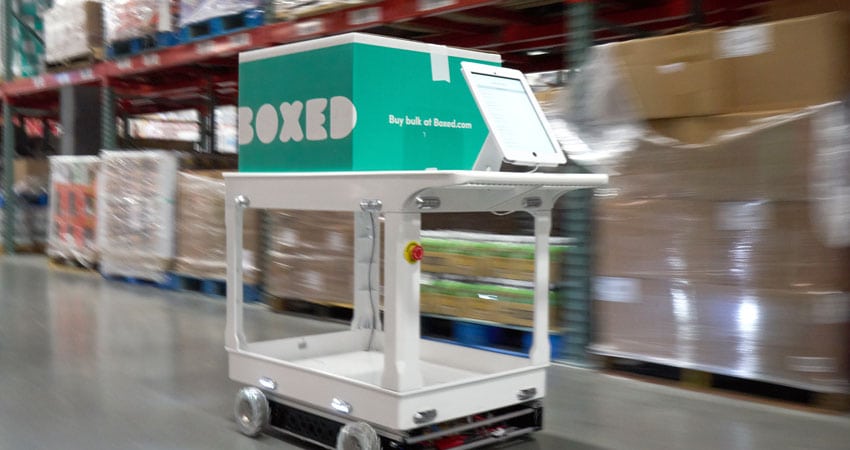Taking a DIY approach to warehouse robotics, Boxed.com has developed its own autonomous ground vehicle (AGV) to help associates with picking and gain operational efficiency.
The prototype AGV is being tested at a Boxed.com fulfillment center in Union, NJ, delivering picked orders to pack stations. Plans call for deploying up to 40 units at each of its three other facilities (Las Vegas, Dallas, Atlanta) in 2018; testing will continue in several weeks at the Dallas location.
The plan, says Chief Technology Officer Will Fong, is to realize 80% of the efficiency gains of automated systems like sorters and conveyors at about 10% of the cost. Boxed.com automated its Union facility earlier this year.
“We spent the early part of 2017 having one of our engineers prove out the core concepts,” Fong said. “Then in July we decided, let’s staff this thing and do it ourselves using open source software. In 90 days we came up with a prototype. It was a very short development cycle.” Fong said technology advances like CPU power and computer vision make a DIY project possible today that would have been unthinkable a few years back outside of large companies with huge development budgets.
The automated cart has an onboard iPad to manage its functions and process commands, and runs on a Tesla battery. It has a camera for vision and a light for detection; sensors help keep it clear of obstructions and humans. The cart can move back and forth, left and right, and pull over to let pickers load on items, then scoot on to the next station. With a large space on top and below, the AGV was designed to handle Boxed.com’s stock-in-trade: Bulk orders of consumer goods.
“It’s essentially goods-to-person,” Fong said. “In a manual facility, a picker moves through the pick zones. In this case, the AGV is doing what conveyors do, bringing items to the pick zone. The cart comes up and a picker puts on items and sends it on to its next destination. The efficiency gains are from minimizing (associate) travel.”
Like other AGVs built for ecommerce fulfillment, the Boxed.com AGV was designed to require very little retrofitting of existing facilities. There were some tweaks to spacing and warehouse software modifications, but “really it’s almost turnkey,” Fong said. “Initially we thought we would need lanes on the floor, but found we don’t anymore. The physical adjustments to the FC are rather minimal by design.”
The company’s team – two engineers, an assistant and a project manager – set it up to handle the unique characteristics of Boxed’s model and facilities. Fong said an average order has 10 different products, and the FCs generally contain a curated assortment of about 1,500 SKUs, small compared to many ecommerce companies.
While initial testing has been limited to picking operations, Fong said long-term plans call for other types of functions like replenishment of pick zones.
“When we roll it out and deploy it after testing and iterations, our goal is to increase picks per hour per picker by 80%,” he said. “Then we’ll reallocate and balance out the entire system, needing fewer pickers, who we’ll retrain to be packers, bumping up the efficiency of the entire FC.”

